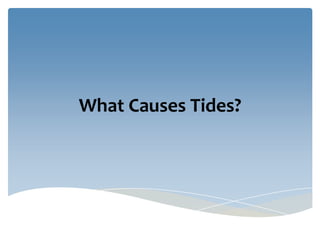
Mouse mischief tides
- 1. READ THIS SLIDE FIRST(This is a hidden slide and will not appear in the slide show) This presentation requires Microsoft Mouse Mischief. Mouse Mischief lets students use computer mice to answer questions and participate in activities teachers create in PowerPoint presentations. To learn more, visit www.microsoft.com/mousemischief Get Microsoft Mouse Mischief 1 Download and Install Download and install the Mouse Mischief add-in. Copy and pastewww.microsoft.com/mousemischiefinto your browser window to visit the site. 2 Restart PowerPoint After installation is complete, restart PowerPoint. 3 Create Use the Mouse Mischief features on the Multiple-Mouse tab. 4 Play Slide Show To play a multiple-mouse slide show (such as this file), click the Play Slide Show button. The Microsoft® Mouse Mischief™ add-in works with Microsoft® PowerPoint® 2010 or Microsoft® Office PowerPoint® 2007.
- 3. What Are Tides? Have you spent a day on an ocean beach and noticed that the water comes in closer or goes out farther during the day? Have you wondered why the water does this?
- 4. The water rises and falls because of the tides. There are two high tides and two low tides in a little less than 25 hours—just a little more than one full day. What Are Tides?
- 5. You arrive at the beach at 9:00 A.M. You lay a towel on the sand, and then you run 30 steps to reach the water’s edge. By 3:00 P.M., the water has almost reached your towel. What do you think happened? The waves got bigger. Rainwater filled up the sea. The tide came in.
- 6. What Causes Tides? Basically, tides are caused by the moon’s gravity. The moon pulls water on the Earth toward itself, causing a bulge on the side of the Earth near the moon. Water bulges on the side of the Earth nearest the moon. But there’s more to it than that.
- 7. What Else Is Happening? The Earth rotates one full turn in 24 hours, but the bulge of water stays on the side of the Earth facing the moon. The bulge stays in place as the Earth moves under it. The moon also orbits around the Earth about every 27 to 28 days. Earth rotates this way. Moon orbits this way.
- 8. Draw an arrow to show which way the Earth rotates, then draw another arrow to show which way the moon orbits around the Earth.
- 9. Earlier we said that it takes almost 25 hours for a cycle of tides to finish. But why is this so, if a day is only 24 hours long? How Else Does the Moon Affect the Tides? The moon is a little farther East every day. This also means that the water bulge caused by the moon’s gravity arrives a little later every day.
- 10. Moon and Earth Move The Earth must rotate a little more before any one place is as close to the moon as it was the day before. That’s why it takes more than one full day for the tides to finish a full cycle. Noon on Tuesday Earth’s North Pole Moon orbits this way Noon on Monday
- 11. On Saturday at the beach, the water is highest at 11:15 A.M. On Sunday, the water is highest at 11:55 A.M. Why does the tide come in later? It’s really the same time, but your watch is fast, so you think it’s earlier. The moon has moved a little, so the beach is closest to the moon at a later time. The tide always comes in later on Sunday.
- 12. Why Are There Two High Tides and Two Low Tides? There are really two bulges of water on the Earth. One bulge is toward the moon. The other bulge is on the far side of Earth from the moon. Why? Have you ever ridden a carousel? Did you feel your body pulled to the outsideas the carousel spun? The same thing happens to water on Earth.
- 13. The Earth and Moon Really Orbit Each Other We say that the moon orbits the Earth, but in fact, the Earth moves a little too, because of the moon’s gravity. Common center of gravity The Earth and moon both orbit a common point.
- 14. As the Earth follows the moon’s gravity, some water on the Earth is pulled in the opposite direction. Some Water is Spun into the Opposite Direction from the Moon Earth’s movement pulls other water in the opposite direction. Moon’s gravity pulls some water toward the moon. Where the water bulges are, the tide is high. Between the bulges, the tide is low. That’s why there are two high tides and two low tides each day.
- 15. You’re on the beach at midnight. The moon is right overhead. Will the tide be… …high, because the moon is as close as it can be to where you are? …between low and high, because the tide rises and sets with the Sun? …low, because the tide is caused by the Sun’s gravity?
- 16. Draw where you would expect the bulges of water that cause high tides to be.
- 17. The sun is rising, but you can still see the moon in the western sky. Would you expect the tide to be going out?
